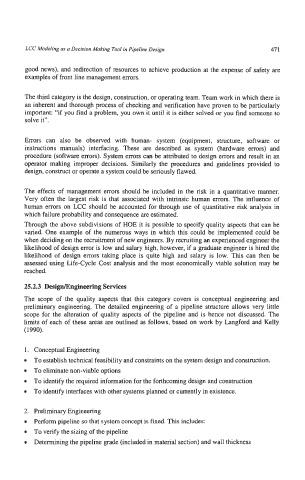Page 504 - Pipelines and Risers
P. 504
LCC Modeling as a Decision Making Tool in Pipeline Design 471
good news), and redirection of resources to achieve production at the expense of safety are
examples of front line management errors.
The third category is the design, construction, or operating team. Team work in which there is
an inherent and thorough process of checking and verification have proven to be particularly
important: “if you find a problem, you own it until it is either solved or you find someone to
solve it”.
Errors can also be observed with human- system (equipment, structure, software or
instructions manuals) interfacing. These are described as system (hardware errors) and
procedure (software errors). System errors can be attributed to design errors and result in an
operator making improper decisions. Similarly the procedures and guidelines provided to
design, construct or operate a system could be seriously flawed.
The effects of management errors should be included in the risk in a quantitative manner.
Very often the largest risk is that associated with intrinsic human errors. The influence of
human errors on LCC should be accounted for through use of quantitative risk analysis in
which failure probability and consequence are estimated.
Through the above subdivisions of HOE it is possible to specify quality aspects that can be
varied. One example of the numerous ways in which this could be implemented could be
when deciding on the recruitment of new engineers. By recruiting an experienced engineer the
likelihood of design error is low and salary high, however, if a graduate engineer is hired the
likelihood of design errors taking place is quite high and salary is low. This can then be
assessed using Life-Cycle Cost analysis and the most economically viable solution may be
reached.
25.23 DesignEngineering Services
The scope of the quality aspects that this category covers is conceptual engineering and
preliminary engineering. The detailed engineering of a pipeline structure allows very little
scope for the alteration of quality aspects of the pipeline and is hence not discussed. The
limits of each of these areas are outlined as follows, based on work by Langford and Kelly
(1990).
1. Conceptual Engineering
To establish technical feasibility and constraints on the system design and construction.
To eliminate non-viable options
To identify the required information for the forthcoming design and construction
To identify interfaces with other systems planned or currently in existence.
2. Preliminary Engineering
Perform pipeline so that system concept is fixed. This includes:
To verify the sizing of the pipeline
Determining the pipeline grade (included in material section) and wall thickness

